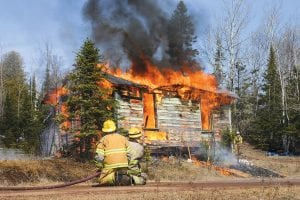Firefighters from the Lutsen, Tofte, Schroeder, and Colvill fire departments conducted live-burn exercises in Lutsen on Saturday, April 9. Firefighters practiced the skills they learned in Firefighter I and II training, burning three structures. Firefighters Nate Clay and Matt Farley stand ready on fire hoses to ensure the fire does not spread from the burning cabin.

Members of local volunteer fire departments had valuable live fire experience in Lutsen on Saturday, April 9, when three vacant structures were burned under the watchful eye of Mesabi Range Community & Technical College Firefighter Training instructors. The Lutsen Fire Department organized the live fire training and members of the Lutsen, Tofte, Schroeder, and Colvill fire departments, Lutsen First Responders, and Cook County Ambulance participated.
The first two structures on Massie Road were donated to the Lutsen Fire Department by David and Mary Brislance of Lutsen. The cabins once belonged to Irving Hansen, but had long ago fallen into disrepair and instead of having them hauled off, the Brislances agreed to let the fire departments use them for practice. After those two cabins were successfully burned, firefighters moved to a cabin at 5211 W. Highway 61 owned by Roger Hagberg.
Lead Instructor from Mesabi Range Community College was Jeff Mayer. Firefighters were at the Lutsen Fire Hall at 8 a.m. to be briefed on the live burn plan. At about 9:30 a.m., four fire trucks were on the first scene—three engines and one tender.
Under supervision of the Mesabi Range instructors, the firefighters lit fires inside rooms in the house, using hay bales and wood pallets. Firefighters took turns entering the cabins in pairs. Teams entered and exited and others managed the hoses outside and ran the engines to provide water as needed. Colvill firefighters provided “exposure protection,” standing watch in the woods around the structures, ensuring that no firebrands started secondary fires. First Responders and ambulance personnel monitored the firefighters, taking blood pressure and making sure they stayed hydrated.
The first cabin offered minimal challenge for firefighters, as it was quite old and no longer had windows, however firefighters were able to experience what it feels like to enter a smoldering, smoke-filled building. The second cabin in the live burn exercise offered more challenge, as it had intact windows, two doors, one with a portico. Firefighters entered from both doors, extinguishing the fire over and over. Finally, as the fire was getting stronger, one last team entered and “ventilated” the structure—breaking out the window glass and spraying water through the building.
After the ventilation, the instructors determined that conditions were becoming hazardous and firefighters were ordered out and away from the cabin. “Sound the horn,” shouted Lead Instructor Mayer, and all of the four fire engines on the scene sounded the alarm.
The fire grew and the cabin was completely reduced to ashes within about a half hour. Even as it burned to the ground, the instructors continued to teach.
Over the radio, instructors called out, “Will the roof cave in first or will the walls fall first?” “Will the walls fall in or out?” Instructors talked about the patterns of fire but stressed that every fire is different.
In addition to being a sturdier structure, with insulation, flooring, and interior walls, the Hagberg cabin added another dimension—a lot of traffic, on Highway 61 and onlookers on the access road— so in addition to practicing firefighting skills, firefighters were tasked with more scene safety concerns.
“It burned a lot hotter than the others,” said Lutsen Fire Chief Paul Goettl. “We used a lot more water.”
Live burn exercises such as this are not only good practice for area firefighters, participating in such an exercise is a requirement for completion of the Firefighter I and II classes. Goettl thanked the firefighters for all their hard work— several members of the Lutsen, Tofte, and Schroeder fire departments have completed this extensive training in recent months. “It was really good training,” said Goettl, “It was really hot—we melted three helmets!”
Goettl expressed appreciation to the property owners for giving the firefighters this training opportunity. He also said thanks to all the volunteers who helped out from Lutsen, Colvill, Tofte, and Schroeder.


Loading Comments